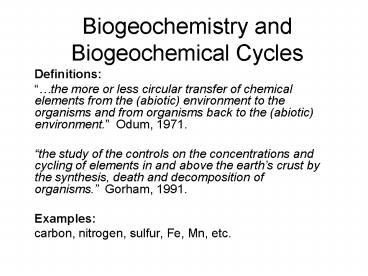Biogeochemistry and Biogeochemical Cycles - PowerPoint PPT Presentation
1 / 25
Title:
Biogeochemistry and Biogeochemical Cycles
Description:
Biogeochemistry and Biogeochemical Cycles Definitions: the more or less circular transfer of chemical elements from the (abiotic) environment to the organisms ... – PowerPoint PPT presentation
Number of Views:307
Avg rating:3.0/5.0
Title: Biogeochemistry and Biogeochemical Cycles
1
Biogeochemistry and Biogeochemical Cycles
- Definitions
- the more or less circular transfer of chemical
elements from the (abiotic) environment to the
organisms and from organisms back to the
(abiotic) environment. Odum, 1971. - the study of the controls on the concentrations
and cycling of elements in and above the earths
crust by the synthesis, death and decomposition
of organisms. Gorham, 1991. - Examples
- carbon, nitrogen, sulfur, Fe, Mn, etc.
2
Big Picture
- Over the long term, biogeochemical cycling has
played a fundamental role in planetary evolution
on Earth (especially the atmosphere and
hydrosphere).Example rise of O2 in Earths
atmosphere. - At present, many biogeochemical cycles are
effectively treated as dynamic equilibria among
cycled materials. - Anthropogenic effects are measurable.
3
(No Transcript)
4
Orbital Variations
Eccentricity100,000 yr
Tilt 41,000 yr
Precession23,000 yr
5
(No Transcript)
6
(No Transcript)
7
(No Transcript)
8
(No Transcript)
9
(No Transcript)
10
(No Transcript)
11
(No Transcript)
12
(No Transcript)
13
(No Transcript)
14
From Albarede, 2003
15
Residence Time (steady state)Response Time (non
steady-state)
- Definition Average time the substance spends in
the reservoir. It is the time required to double
the concentration in a reservoir (if output
ceased). - Ri amti in reservoir/fluxi Example residence
timeswater in atmosphere 11 days water in
ocean 3550 yr - Materials can be imported and exported from
ecosystems and long-term storage pools.
16
(No Transcript)
17
(No Transcript)
18
(No Transcript)
19
Basic Biogeochemical Cycle
System boundary
Available Abiotic Pool
20
(No Transcript)
21
Major, Minor, and Trace Elements in
Biogeochemical Cycles
- Major elemental components of living organisms
(C, H, O, N, P, S) - Carbohydrates, proteins, lipids, nucleic acids
- Minor elements Ca, K, Mg, Na, Si
- Trace elements B, Co, Cr, Cu, Fe, Mn, Mo, Ni,
Se, Sn, V, Zn, REEs - Ca and Si are only minor components of
protoplasm, but are major components of exo and
endoskeletons of microorgs and macroorgs - Fe, Mn, N, S are also cycled rapidly via redox
processes which may not be directly coupled to
the production and decay of organic matter
22
(students run screaming from the room)
23
(No Transcript)
24
A Partially Open Biogeochemical Cycle The
Oceanic Carbon System
Atmosphere
CO2
Shallow Sea
Dissolved Inorganic Carbon
EXCHANGE OF WATER
EXCHANGE OF WATER
Organically-Bound Carbon
Organic carbon
Carbonate particles
Long-term removal
Deep Sea
25
(No Transcript)































